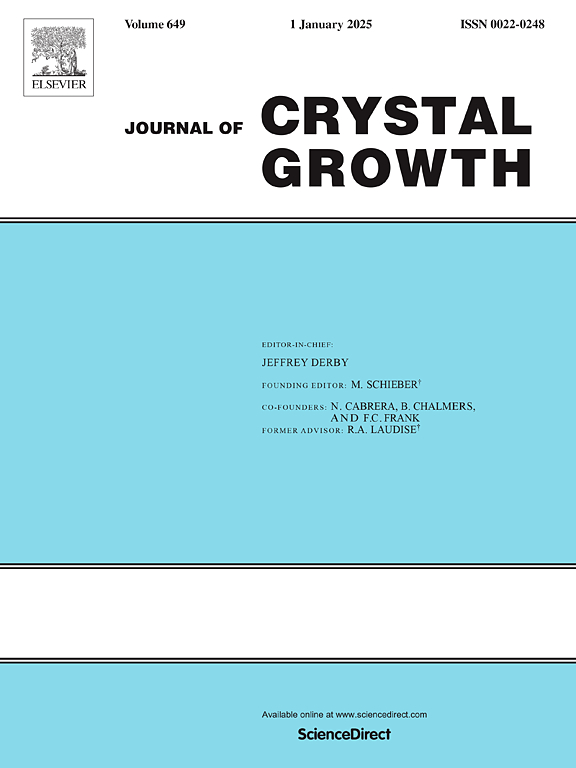Deep learning with slow feature analysis for silicon single crystal growth state identification in Czochralski process
IF 2
4区 材料科学
Q3 CRYSTALLOGRAPHY
引用次数: 0
Abstract
The preparation of semiconductor silicon single crystal for advanced chip process requirements is the top priority of the current integrated circuit industry development. In this process, real-time and accurate identification of the growth state of Czochralski silicon single crystals (Cz-SSC) is the key to ensuring stable and improved crystal quality. Due to the switching of operating conditions, environmental disturbances and high dependence on operator experience, the process dynamics are highly complex, and minor anomalies are often masked by normal operating conditions, posing a serious challenge to real-time crystal growth state identification. To solve this problem, this study proposes a Cz-SSC growth state identification method that integrates slow feature analysis (SFA) and deep learning. Firstly, SFA extracts slow features reflecting the nature of process evolution at the time scale to reduce the masking effect of anomalies on minor anomalies from the source; subsequently, a multi-scale one-dimensional convolutional neural network (MS-1DCNN) is designed and a cross-attention mechanism is introduced for features extracted from convolutional kernels of various scales to achieve the weighted fusion of cross-scalar information, thus comprehensively capturing the discriminative patterns at different time scales. Finally, the experimental results demonstrate that the proposed method achieves superior performance in crystal growth state recognition, outperforming other approaches in terms of overall accuracy, recall, and F1-score. This Cz-SSC growth state identification method provides an effective solution for fine control of the semiconductor SSC manufacturing process.
基于慢特征分析的深度学习在单晶生长状态识别中的应用
制备符合先进芯片工艺要求的半导体硅单晶是当前集成电路产业发展的重中之重。在此过程中,实时准确地识别Cz-SSC的生长状态是保证晶体质量稳定和提高的关键。由于操作条件的切换、环境的干扰以及对操作人员经验的高度依赖,过程动态非常复杂,微小的异常往往被正常的操作条件所掩盖,对晶体生长状态的实时识别提出了严峻的挑战。为了解决这一问题,本研究提出了一种结合慢特征分析(slow feature analysis, SFA)和深度学习的Cz-SSC生长状态识别方法。首先,SFA在时间尺度上提取反映过程演化性质的慢特征,从源头上降低异常对小异常的掩蔽效应;随后,设计了一种多尺度一维卷积神经网络(MS-1DCNN),并对不同尺度卷积核提取的特征引入交叉注意机制,实现跨标量信息的加权融合,从而全面捕获不同时间尺度下的判别模式。最后,实验结果表明,该方法在晶体生长状态识别方面取得了优异的性能,在总体准确率、召回率和f1分数方面都优于其他方法。这种Cz-SSC生长状态识别方法为半导体SSC制造过程的精细控制提供了有效的解决方案。
本文章由计算机程序翻译,如有差异,请以英文原文为准。
求助全文
约1分钟内获得全文
求助全文
来源期刊

Journal of Crystal Growth
化学-晶体学
CiteScore
3.60
自引率
11.10%
发文量
373
审稿时长
65 days
期刊介绍:
The journal offers a common reference and publication source for workers engaged in research on the experimental and theoretical aspects of crystal growth and its applications, e.g. in devices. Experimental and theoretical contributions are published in the following fields: theory of nucleation and growth, molecular kinetics and transport phenomena, crystallization in viscous media such as polymers and glasses; crystal growth of metals, minerals, semiconductors, superconductors, magnetics, inorganic, organic and biological substances in bulk or as thin films; molecular beam epitaxy, chemical vapor deposition, growth of III-V and II-VI and other semiconductors; characterization of single crystals by physical and chemical methods; apparatus, instrumentation and techniques for crystal growth, and purification methods; multilayer heterostructures and their characterisation with an emphasis on crystal growth and epitaxial aspects of electronic materials. A special feature of the journal is the periodic inclusion of proceedings of symposia and conferences on relevant aspects of crystal growth.
 求助内容:
求助内容: 应助结果提醒方式:
应助结果提醒方式:


